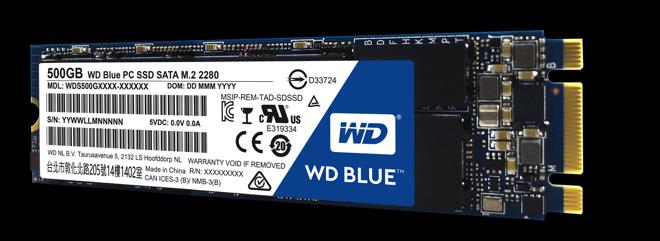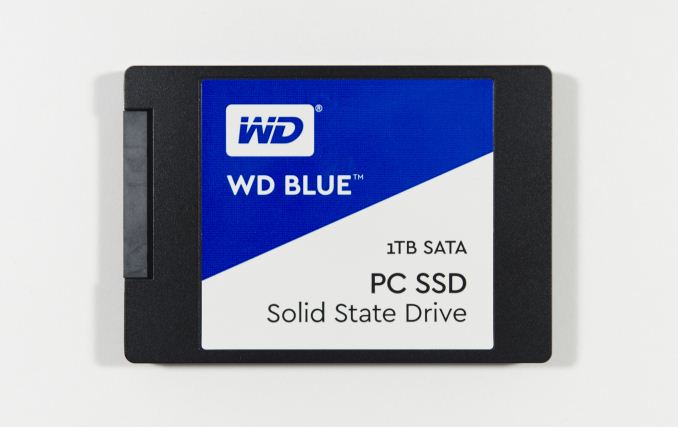Western Digital Introduces WD Blue And WD Green SSDs
by Billy Tallis on October 11, 2016 8:02 AM EST- Posted in
- SSDs
- Storage
- Western Digital
- SanDisk
- TLC

Five months ago, Western Digital completed its acquisition of SSD and NAND flash manufacturer SanDisk, adding consumer SSDs and more enterprise SSDs to their existing portfolio of hard drives and HGST enterprise SSDs. WD is now introducing two families of WD-branded consumer SSDs, each derived from existing SanDisk product lines.
The WD Blue SSD is based on the SanDisk X400 SATA SSD with minimal hardware changes but has modified firmware and different usable capacities. Like the X400, the WD Blue is available as either a 2.5" or M.2 drive and uses SanDisk 15nm TLC NAND with the Marvell 88SS1074 controller. Our review of the 1TB WD Blue SSD shows that it improves on some of the X400's weaknesses but sacrifices some performance on many tests, producing a drive that is not quite as fast overall. The MSRP for the WD Blue is about the same as current actual retail prices for the SanDisk X400, which position it as a mid-range SATA SSD and puts it up against formidable competition from the new wave of drives using the more affordable 3D TLC NAND from Micron.
| Western Digital WD Blue Specifications | |||||
| Capacity | 250GB | 500GB | 1000GB | ||
| Form Factor | 2.5" 7mm SATA or M.2 2280 SATA | ||||
| Controller | Marvell 88SS1074 | ||||
| NAND | SanDisk 15nm TLC | ||||
| Sequential Read | 540 MB/s | 545 MB/s | 545 MB/s | ||
| Sequential Write | 500 MB/s | 525 MB/s | 525 MB/s | ||
| 4KB Random Read | 97k IOPS | 100k IOPS | 100k IOPS | ||
| 4KB Random Write | 79k IOPS | 80k IOPS | 80k IOPS | ||
| Average Power | 70 mW | ||||
| Max Power | 4.4 W | ||||
| Encryption | No | ||||
| Endurance (TBW) | 100 TB | 200 TB | 400 TB | ||
| Warranty | Three years | ||||
| MSRP | $79.99 | $139.99 | $299.99 | ||
The WD Green SSD is an entry-level product line with limited capacity options. Based on the SanDisk SSD Plus, it uses a Silicon Motion controller in a DRAM-less configuration with SanDisk 15nm TLC NAND. The WD Green has a similar purpose to drives like the Samsung 750 EVO and the recently-announced OCZ TL100: to offer the lowest possible price while still providing acceptable reliability and a noticeable performance jump over hard drives. Higher capacities are omitted from the product line because the total price would be too high for the most cost-sensitive consumers even if the price per GB is marginally lower than a more mainstream budget drive.
While the Green label has connotations of better than average power efficiency when applied to WD's hard drives, the low performance of DRAM-less SSDs usually leads to poor energy efficiency during active use and the idle power savings tend to be minimal.
The WD Green will be available later this quarter, and pricing has not been announced.
| Western Digital WD Green Specifications | ||||
| Capacity | 120GB | 240GB | ||
| Form Factor | 2.5" 7mm SATA or M.2 2280 SATA | |||
| Controller | Silicon Motion SM2256S | |||
| NAND | SanDisk 15nm TLC | |||
| Sequential Read | 540 MB/s | 545 MB/s | ||
| Sequential Write | 405 MB/s | 435 MB/s | ||
| 4KB Random Read | 37k IOPS | 37k IOPS | ||
| 4KB Random Write | 63k IOPS | 68k IOPS | ||
| Idle Power | 30 mW | |||
| Encryption | No | |||
| Endurance (TBW) | 40 TB | 80 TB | ||
| Warranty | Three years | |||
Source: Western Digital












13 Comments
View All Comments
MrSpadge - Tuesday, October 11, 2016 - link
People expect the green to be the slowest HDD and silent - check. Capacity is a different matter: there are / have also been 500 GB and 1 TB Greens.mikato - Tuesday, October 11, 2016 - link
"While the Green label has connotations of better than average power efficiency when applied to WD's hard drives, the low performance of DRAM-less SSDs usually leads to poor energy efficiency during active use and the idle power savings tend to be minimal."This seems strange to me. Minimal idle power savings over hard drives? I guess they don't use a whole lot to begin with, single digit watts, but how much are we talking about here?
Billy Tallis - Tuesday, October 11, 2016 - link
I meant that the DRAMless SSDs tend to not have significantly better idle power consumption than SSDs with DRAM caches. Either way, their idle power tends to be just a few tens of mW when they're put in to power saving mode. The WD Green SSD is not likely to offer better laptop battery life than the WD Blue SSD.